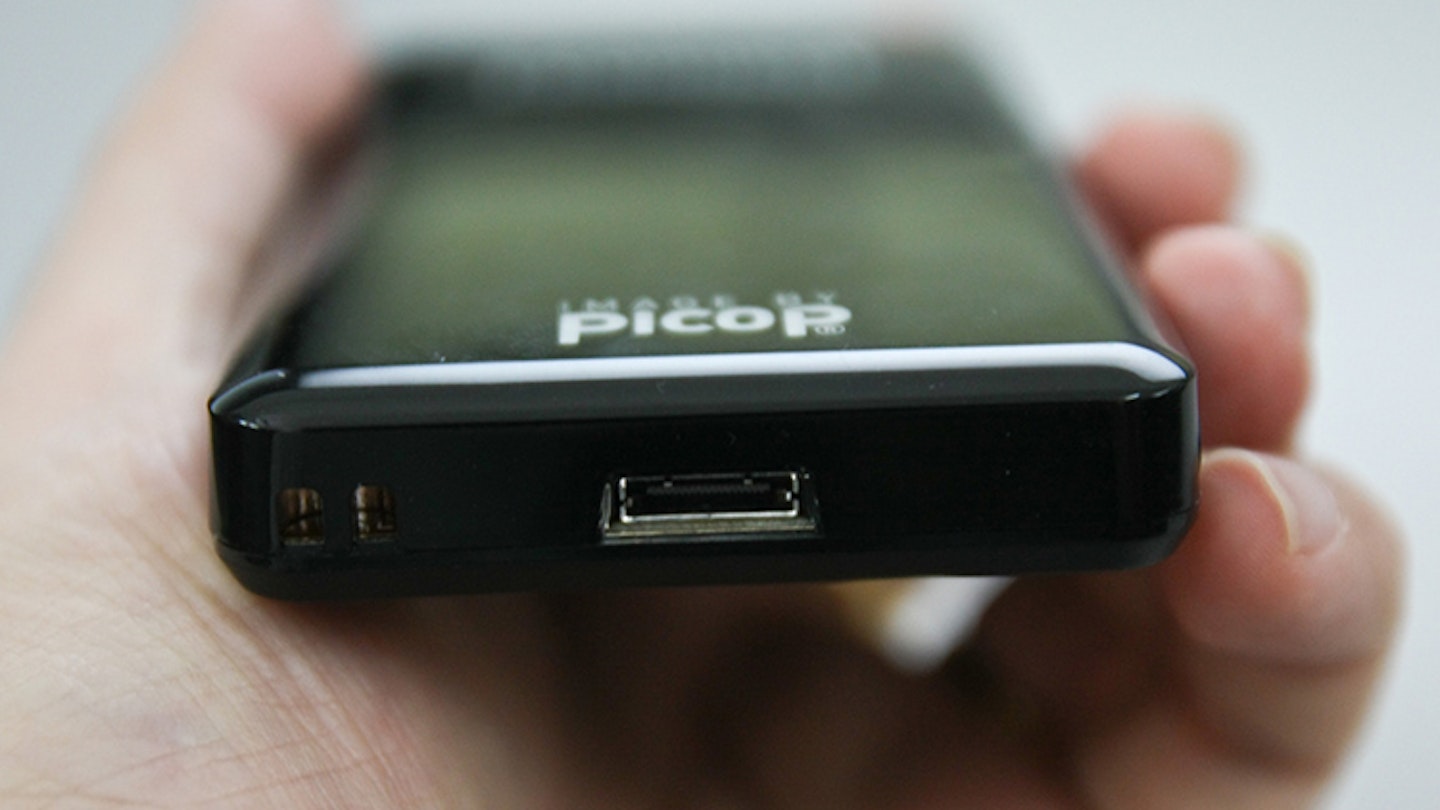Packing the right tech can help take some of the stress out of work trips and let you concentrate on the more enjoyable elements of business travel. Check off this list before you step on that plane, board the train or jump in the car, and you'll be ready for anything.
Pocket projector by Cheon Fong Liew. CC BY-SA 2.0.
Pocket projector: a range of palm-sized, surprisingly powerful digital projectors can connect to a laptop using an HDMI cable. Tuck one away in your luggage and whip it out for an impromptu presentation.
Google Chromecast: this little USB-powered HDMI dongle (www.google.com/intl/en-GB/chrome/devices/chromecast) plugs into the the HDMI port of modern TVs and lets you stream video from your laptop or phone with an app. It's impressive, but make sure you have back-up cables to attach your laptop directly.
Digital camera: bring a camera, be it a happy snappy or just your phone. People often forget to take photos of staff and clients in other offices and locations - useful for those back in the office at home or to document the presentation or event for a blog or investors.
Security devices: you may not realise it, but your laptop comes with a little hole called a Kensington Lock. This rice grain-sized opening on the side of your laptop, and other valuable electronics, fits a cable lock, similar to a bike lock, allowing you to fasten it to a desk leg, or hotel furniture, reducing the risk of opportunistic theft. A more high-tech version is a Bluetooth tracker and alarm tag, such as the Smart-Tie (www.itsminetechnology.com/smart-alarms). These do the same thing, but the cable ‘lock’ here is Bluetooth. If an iPhone or laptop paired with the device leaves a certain range, the tracker vibrates or emits a piercing alarm.
Portable keyboard by Karlis Dambrans. CC BY 2.0.
Portable keyboards: travel keyboards come in two main types, full-sized or mini. Full-sized keyboards can be folded in half or rolled up. The advantage of full-sized keyboards is being able to write comfortably on adult-sized keys, with all the regular arrow buttons and sometimes the numeric keypad. This is important if you have large hands or need to type for long periods. The soft, rubbery keyboards are convenient, but can be difficult to type on because of the ‘mushy’ buttons. They also look like toys and definitely don't look professional.
Mini keyboards can be phone-sized or built into tablet cases – either wired or connected through Bluetooth. They're extremely portable and can be taken along ‘just in case’. Price and build quality vary greatly, and some keyboards are tailored specifically to the tablet, such as offering iPad-specific volume buttons or Android-tailored back buttons. These keyboards usually run on AA batteries, are rechargeable, or only work when tethered to your tablet by using its battery. Wireless keyboards can be less responsive, making typing slow at times.
USB travel iron: for small creases, a phone-sized portable iron is a handy gadget. These charge by USB (or use AAA batteries) and work well when you’re on the go for small jobs such as smoothing a skirt after a flight or de-creasing a tie before a meeting, but they aren’t large or hot enough for normal ironing.
Alarm apps: you don’t have to stick with your smartphone’s built-in alarm. Modern apps let you choose your own music as the alarm, ramping up the volume gradually to ease you into your work day. If you have real trouble with ‘snooze’ addiction, some apps even make you perform a maths problem before switching off the alarm.
Cloud services and syncing: if your laptop or phone’s documents, images and other files were damaged or went missing, could you replace them? To make sure the answer is yes, install a cloud service app on your laptop or smartphone, such as Dropbox (www.dropbox.com), Google Drive (drive.google.com), or Microsoft’s Skydrive (skydrive.live.com). Any document you create, or photo you take, can be saved automatically to the cloud every time you connect to wi-fi. For your phone contacts and calendar, Android phones can do this automatically with a signed-in Google account, and iPhones do the same using iCloud. This means you can access this information from any computer connected to the internet.
Thumb drive by Cal Evans. CC BY-SA 2.0.
USB keys and thumb drives: don’t depend on the internet for your presentation. Things can (and often do) go wrong, so keep a back-up of important documents on a USB key. If you need to use a particular piece of software for a meeting, look for a ‘portable’ version which can run from a flash drive without needing to be installed on the computer you’ll be using on your work trip. Examples include PDF and document viewers, web browsers, and Skype. See www.portableapps.com for 300 more free, legal apps.
Luggage: new luggage technology includes suitcases that can weigh themselves, displaying the weight on an LCD display on the handle. Or just bring your own handheld digital scales. To speed through security checks, consider a backpack or briefcase with a laptop compartment (try ‘Security Fast Pass’ by Victorinox) that unzips completely for quick access to your computer. You don’t even have to remove the laptop from the bag. It may sound trivial, but it cuts down on the stress of that security queue.
If you’re worried about your suitcase going missing, try out one (by Bag2Go) with built-in GPS that allows you to pinpoint its location at any time from a smartphone app. Business travellers without time to charge their devices can even buy a briefcase or backpack with built-in batteries to charge gadgets (www.mypowerbag.com). Just remember to charge these batteries, too.
Chargers and adapters: most modern electronic devices, such as laptops and smartphones, automatically switch voltage for anywhere in the world. As long as you have an adapter for the plug’s shape, the device will work. You can buy international adapters with a shape to fit most devices in the world. Modern versions also charge USB devices such as smartphones and iPads with a USB cable.
Exceptions, such as electric toothbrushes, often only work with one voltage. If the voltage (find it written on the power adapter of the device) is 110V, or lower than the voltage used in your destination, the device will work with an adapter, but will take much longer to charge, or may not draw enough power to work at all if it needs to be plugged in to operate. The two-pin European shaver plug has pins spaced slightly wider than the regular European two-pin shape. This means not all international adapters work with it.
Just in case you can’t get to a working power point, bring a portable or mobile battery pack to charge all your gear. This is especially important in developing countries with power rationing.
Cables: check you have all the right cables before you travel. Some cables look alike, such as mini USB (used with most digital cameras), micro USB (used with smartphones), and USB printer cables, but are incompatible. Don’t assume that if your destination has a projector, for example, they will have the HDMI cable to connect it to your computer. Make sure you have a back-up method, such as a VGA cable. Keep your kit tidy with a cable tamer or storage case.
Roaming and the internet: make sure your phone is unlocked if you want to use a local SIM card in a destination country - for example, a locked phone from Vodafone in the UK won't work with a SIM from Vodafone in Australia. Also make sure that your phone works on the cellular network of the destination country. Most modern phones are quad-band and work in any country. If you don’t want to pay for expensive data roaming charges on your phone abroad, turn off data roaming to stop apps accessing the internet without your knowledge. You can still use wi-fi.
Phillip Tang loves etymology, foreign supermarkets and animated GIFs. Follow his sparkling rants and photos on travel, technology and how we humans live @philliptang and on Google +.
Stay unruffled in every situation with Lonely Planet's Best Ever Travel Tips.
















